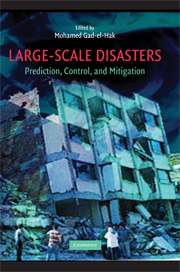Book contents
- Frontmatter
- Contents
- Preface
- About the editor
- List of contributors
- 1 Introduction
- 2 The art and science of large-scale disasters
- 3 Multiscale modeling for large-scale disaster applications
- 4 Addressing the root causes of large-scale disasters
- 5 Issues in disaster relief logistics
- 6 Large-scale disasters: perspectives on medical response
- 7 Augmentation of health care capacity in large-scale disasters
- 8 Energy, climate change, and how to avoid a manmade disaster
- 9 Seawater agriculture for energy, warming, food, land, and water
- 10 Natural and anthropogenic aerosol-related hazards affecting megacities
- 11 Tsunamis: manifestation and aftermath
- 12 Intermediate-scale dynamics of the upper troposphere and stratosphere
- 13 Coupled weather–chemistry modeling
- 14 Seasonal-to-decadal prediction using climate models: successes and challenges
- 15 Climate change and related disasters
- 16 Impact of climate change on precipitation
- 17 Weather-related disasters in arid lands
- 18 The first hundred years of numerical weather prediction
- 19 Fundamental issues in numerical weather prediction
- 20 Space measurements for disaster response: the International Charter
- 21 Weather satellite measurements: their use for prediction
- Epilogue
- Index
5 - Issues in disaster relief logistics
Published online by Cambridge University Press: 20 October 2009
- Frontmatter
- Contents
- Preface
- About the editor
- List of contributors
- 1 Introduction
- 2 The art and science of large-scale disasters
- 3 Multiscale modeling for large-scale disaster applications
- 4 Addressing the root causes of large-scale disasters
- 5 Issues in disaster relief logistics
- 6 Large-scale disasters: perspectives on medical response
- 7 Augmentation of health care capacity in large-scale disasters
- 8 Energy, climate change, and how to avoid a manmade disaster
- 9 Seawater agriculture for energy, warming, food, land, and water
- 10 Natural and anthropogenic aerosol-related hazards affecting megacities
- 11 Tsunamis: manifestation and aftermath
- 12 Intermediate-scale dynamics of the upper troposphere and stratosphere
- 13 Coupled weather–chemistry modeling
- 14 Seasonal-to-decadal prediction using climate models: successes and challenges
- 15 Climate change and related disasters
- 16 Impact of climate change on precipitation
- 17 Weather-related disasters in arid lands
- 18 The first hundred years of numerical weather prediction
- 19 Fundamental issues in numerical weather prediction
- 20 Space measurements for disaster response: the International Charter
- 21 Weather satellite measurements: their use for prediction
- Epilogue
- Index
Summary
[T]he most deadly killer in any humanitarian emergency is not dehydration, measles, malnutrition or the weather, it is bad management …
(John Telford, former senior emergency preparedness and response officer, United Nations High Commissioner for Refugees)This book covers scientific approaches and issues thereof to predicting, preparing, and responding to large-scale disasters. Even though scientific models may help tremendously in capturing most of the facets of each of these three stages, softer and hard-to-model issues surface at their interface. This chapter primarily looks at the soft issues at the interface of preparation and response which is logistics. Logistical problems in the private sector have been widely researched in the field of operations research and management science. This chapter reviews some of these modeling approaches that relate to disaster relief. However, the logistics of disaster relief present certain complex challenges that cannot be easily incorporated into mathematical models, yet directly affect the outcome of relief operations. Such challenges are the main interest of this chapter.
Introduction
In 2003, 700 natural events caused 75,000 deaths (almost seven times the number in 2002) and more than $65 billion in estimated economic losses, and affected 213 million people (United Nations Economic and Social Council [ECOSOC], 2004).
- Type
- Chapter
- Information
- Large-Scale DisastersPrediction, Control, and Mitigation, pp. 120 - 146Publisher: Cambridge University PressPrint publication year: 2008
- 24
- Cited by

